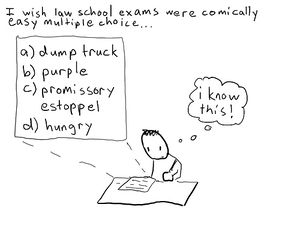Difference between revisions of "Speed Reading"
From Learnmore
(clearspace) |
|||
| Line 33: | Line 33: | ||
==Strategy 1: Reading in blocks== | ==Strategy 1: Reading in blocks== | ||
| − | [[Image:Speedreading-Blocks.jpg|thumb|300px| | + | [[Image:Speedreading-Blocks.jpg|thumb|300px|right|Childsplay!...Thanks to zeitengewimmel www.flickr.com]]When we learn to read, we read one word at a time. Experienced readers however read one block of words at a time, fixing their eyes on one block then moving their eyes to the next block. Skilled readers read a lot of words in one block. |
To improve your reading skills then, you could try to increase the number of words that you read at one time. One technique for doing this is to hold the text further away from you in order to take in a larger block. | To improve your reading skills then, you could try to increase the number of words that you read at one time. One technique for doing this is to hold the text further away from you in order to take in a larger block. | ||
Latest revision as of 14:01, 26 November 2019
Different ways of reading
There are many different ways of reading. Reading from the beginning right through to the end (as you might do when reading a novel) might not be the most effective method when you are dealing with other types of texts.
We already practise a number of techniques in our everyday lives, for example:
Skimming newspaper headlines
Scanning a phone book to find a specific number
The importance of your reading environment and how you read
Where and how you study can make a big difference to how effectively you read.
Here are some tips:
- Try to study in a quiet environment without distractions so as to increase your focus.
- Remember to take short, regular breaks away from reading – especially if you are reading on screen – in order to make sure that you don’t tire your eyes.
- It might sound obvious but, if you are having difficulty in reading, consider going to an optician for an eye test in case there are any underlying problems.
How you can improve your reading speed
As a law student, you will have lots of reading that you need to get through for your course! If you can employ effective reading techniques, this will free up your time to do the other valuable things that you need to do, such as identifying the relevant information, abstracting it and applying it to the legal problems that your tutors ask you to consider.
One of the most useful techniques is speed reading and the good news is that this is something that you can work on yourself and improve with effort over time.
The next sections contain strategies for increasing the rate at which you read. Find out which strategies work for you – there is no point in increasing the rate at which you read if you are not comprehending and retaining the material!
Strategy 1: Reading in blocks
When we learn to read, we read one word at a time. Experienced readers however read one block of words at a time, fixing their eyes on one block then moving their eyes to the next block. Skilled readers read a lot of words in one block.
To improve your reading skills then, you could try to increase the number of words that you read at one time. One technique for doing this is to hold the text further away from you in order to take in a larger block.
You also should reduce the length of time that you look at one block before you move on to another. Remember that your brain only needs a short period of time to grasp information!
Strategy 2: Don't look back!
Experienced readers look at a block of words for an instant, and then move on. They rarely look back at previous sentences. When you are reading something for the first time, try to reduce the number of times you look back at previous sentences.
To encourage yourself to do this, you can run a pointer, e.g. a pen, along the line as you read. Your eye will then follow the sweep of the pointer and be less tempted to look back.
Strategy 3: Avoid subvocalisation
Most of us tend to pronounce the words on a page as we read them – we might say them under our breath as we are reading, or we might say each word in our heads as we go along. This slows us down.
In order to increase your reading speed, try not to pronounce the words as you read. If this is difficult to do, don’t worry and just concentrate on your other reading techniques. Subvocalisation tends to be less of a problem anyway as you learn to read faster.
Strategy 4: Save time by 'pre-reading'
Before you begin to plough through a text book, why not do some pre-reading to work out what you need to concentrate on? For example:
- Before beginning to read a chapter, have a look at the entire thing very quickly. This is often a useful way of picking out key words, unusual words or legal terms that initially catch your eye.
- Try reading the first sentence of each paragraph to get the gist of it. You can then get an idea of whether that paragraph is going to be relevant to you.
- Try identifying the key words you are looking for in advance, and then read around them.
Now test yourself!
In order to find out the rate at which you read, you can do a speed reading test online. If you put the words “speed reading test” into your search engine, you will find lots of free tests available on the Internet.
The following online speed reading exercise from ReadingSoft.com not only tests you on the speed at which you read, but also on your level of comprehension.
ReadingSoft.com is a provider of software solutions for enhanced reading. It was founded in 1998 by Charles Cousin and Michel C. Vinkenbosch.
If you would like to work on your speed reading skills, why not try out some of the above strategies. Then after a few weeks, test your speed and comprehension again to see if you have improved!
Many thanks to Hilary Vieitez for this excellent introduction to speed reading.



